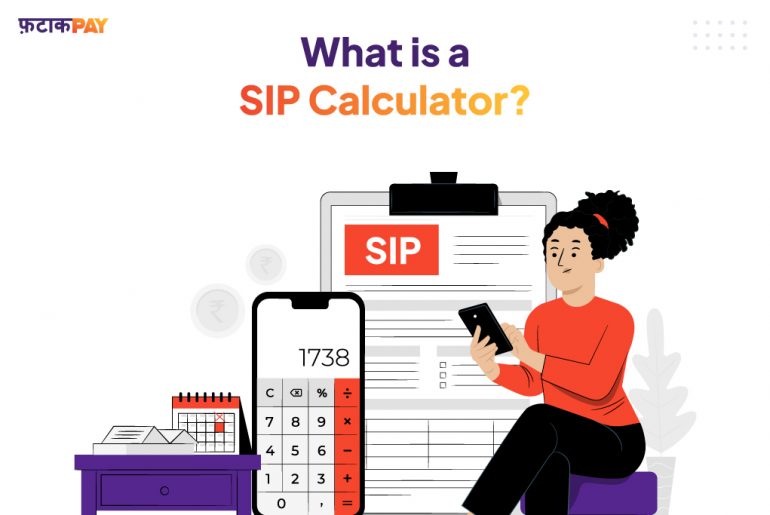Introduction to an SIP Calculator:
Are you looking to invest your money in mutual funds but unsure where to start? A Systematic Investment Plan (SIP) may be the solution for you. Our blog provides a comprehensive guide to SIP investment, including how it works,and its benefits. We have also included an SIP Calculator. Get started on your investment journey with our informative blog on SIPs.
Before we introduce you to the SIP Calculator, let us first understand what an SIP is:
A systematic investment plan (SIP) is a way for investors to invest in mutual funds where they make periodic, automatic payments on a regular basis. You can plan your investments with SIPs to meet your long-term financial objectives. You can achieve this by choosing a mutual fund scheme and deciding on the target amount and the amount you’d like to invest at regular intervals.
Consider the scenario where you want to invest Rs.500 each month for five years. You can automate your contributions for the specified term by setting up an SIP with a mutual fund. Also, you have the option to contribute more or less frequently. SIP mutual funds typically allow for weekly, monthly, quarterly, semi-annual frequency for the various types of investing.
Because SIP is merely a method of investing in mutual funds rather than an asset in and of itself, it’s also crucial to comprehend what it means in terms of mutual funds. Your SIP will invest any contributions you make in a mutual fund plan of your choosing.
How does an SIP work?
From the start of your SIP investment through the point at which your funds are placed in a mutual fund plan, there are four stages:
Selection of a mutual fund scheme:
Choosing a mutual fund plan to invest in is the first stage in the SIP investment process.
Selecting an investment frequency:
Selecting an investment frequency is the following stage in your SIP investment journey. Since they receive their salaries on a monthly basis, monthly frequency is the most popular option, particularly among investors who are employed. But, you can decide to invest weekly, quarterly, semi-annually, or annually if you have good reasons to pick a different frequency.
Set up SIP with a mutual fund scheme:
Once you’ve decided on a mutual fund, setting up your SIP is a straightforward process. If you’re a first-time investor, finish your KYC process, submit your bank information, and then choose your SIP contributions and frequency.
Automatic debits and unit allotment based on NAV:
Money will be deducted from your registered bank account after everything is set up. On the date you choose when setting up the SIP, it will be debited each month. This procedure is automated. Continually deducting money from your bank account in accordance with the frequency you specified while setting up the SIP.
You’ll receive a notification that your funds have been invested shortly after the money has been debited. The acknowledgment also specifies the quantity of units depending on the NAV that you have been allocated (net asset value). Due to daily NAV fluctuations, the amount of units allocated for each contribution may vary.
We’ll shortly get to know more about the SIP calculator. For the time being, let’s now discuss the benefits.
What are the benefits of SIPs?
Rupee-cost averaging:
Because there is no longer a need to time the market, it is one of the most obvious advantages of SIPs. Due to their lack of experience, investors who attempt to time the market by placing bets based on momentary market fluctuations risk losing money in the process. SIPs eliminate guesswork because they involve investing a set sum at regular intervals regardless of the state of the market. You receive more units for your investment when the markets are down and the mutual fund’s NAV is low. On the other hand, you receive less units when the markets are up. This lowers your average cost per allocated unit over the long term.
Let’s take an example where you’ve opted to invest Rs.5,000 via an SIP over the course of the next five months. How rupee-cost averaging will benefit you:
| Asset Classes | Amount invested every month | NAV | Units [Amount invested/NAV] | NAV | Units with Lumpsum |
| Jan | 5000 | 100 | 50 | 100 | 250 |
| Feb | 5000 | 98 | 51.02 | – | – |
| Mar | 5000 | 96 | 52.08 | – | – |
| April | 5000 | 102 | 49.02 | – | – |
| May | 5000 | 100 | 50 | – | – |
| Total | 25000 | 496 | 252.12 | 100 | 250 |
Rupee-cost averaging brings your average NAV cost per unit down to 99.2 [496/ 5]. Your NAV cost per unit would have been 100 if you had invested a flat sum of 25,000 in January. Additionally, if you had committed a lump sum, you would only have been able to buy 250 units (2.11 less units, or 25,000/100 = 250 units).
Also, the investment’s value would have been different. If you had put in Rs.25,000 in January, your investment would have been worth Rs.25,000 in May. However due to rupee cost averaging, the value of your investment with SIPs in May would be Rs.25,211 [i.e., 252.11 units x Rs.100 NAV].
Professional Management:
Experts that have a track record of success as portfolio managers run mutual funds. Additionally, they are supported by a group of research analysts that keep an eye on the markets and assess investment prospects. Let a professional manage your finances rather than putting your money at risk. SIPs essentially allow you to delegate your financial knowledge to a fund manager, who will manage the assets of the mutual fund to maximise returns for its investors. A win-win situation.
Financial Discipline:
Some people may decide to upgrade their lifestyle in response to an increase in income. Conversely, those that are wiser are likely to spend what is left over after investing. SIPs can aid in instilling this discipline because you agree to invest a set sum each month. Additionally, there is no additional work required for monthly contributions. Each month, the funds are automatically debited from your registered account. Compounding causes the tiny sums to accumulate into a sizable sum over time.
Power of compounding:
Compounding helps the returns on your SIP investment, just like it does for other mutual funds.
Types of SIP:
After covering a lot of material on what SIP is, how SIP functions, and the advantages of SIP, let’s speak about the several types of SIPs you can choose from. Don’t worry, we are getting closer to the SIP Calculator 🙂
Fixed SIP:
The standard SIPs are known as fixed SIPs. The rest of the procedure is automated after you select an amount and a deadline for your contribution. You should also be aware that unless you designate an end date manually for these SIPs, they will automatically expire in the year 2099. You shouldn’t be concerned about it because 2099 is so far away. Despite the fact that fixed SIPs are the most popular among investors, there are alternative kinds that may better fit your investing style.
Top-up SIP:
For investors who desire to periodically raise their SIP contributions, top-up SIPs are fantastic. As your income grows year after year, for instance, top-up SIPs might be highly beneficial. By selecting a top-up SIP, the investor could decide whether to add the entire increment or only a portion of it to the SIP. For instance, if your current monthly investment is Rs.20,000 and your income rises by 10% annually, you might opt to increase your contribution by the entire incremental income, a portion of it, or simply by 10%.
Perpetual SIP:
Fixed SIPs with no tenure are what perpetual SIPs are. Once you’ve subscribed, the SIP payment amount will be deducted from your bank account until you tell the fund house to stop withdrawals. Perpetual SIPs are the best choice if you don’t want your investments to be restricted to a specific number of years because they do not require ongoing renewals. Of course, you are always free to redeem your investments.
Flexible SIP:
With a flexible SIP, you have the option of altering the amount of each payment or skipping a few. An investor might decide to alter the contribution amount or forego a contribution for one of two reasons. Initially, the market’s overall outlook is taken into account when adjusting your SIP contributions. Your monthly payments through SIP would be decreased if the market were valued higher and increased again once valuations looked favourable and the markets were accurate. This is done by Mutual fund firms using a predetermined valuation matrix. The minimum and maximum SIP investment amounts are up to you to choose. Please be aware that you must notify the fund house of these changes one week before the due date for your SIP installment.
Additional links:
We hope you found the blog to be useful and informative. Do check out our other blogs and other LinkedIn articles as well.
https://fatakpay.com/blog/what-are-gold-etfs/
https://fatakpay.com/blog/simplifying-gold-investment-online/
https://www.linkedin.com/pulse/what-nbfc-fatakpay/?trackingId=XSBgd40W3Pir0%2FIkANP4kA%3D%3D
About FatakPay:
FatakPay provides virtual credit facilities for all. It’s available on your phone and caters to your everyday needs in both online and offline formats. Payments are done seamlessly through UPI/QR codes. The solution provides an almost zero cost, free, quick, transparent and secure way to transact in a multilingual format with a Scan Now, Pay Later facility and easy repayment options.
Link to FatakPay App: https://link.ftkp.in/2uSI/dkasgvnf







